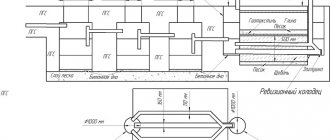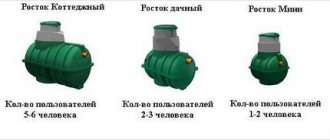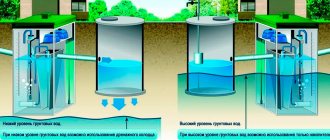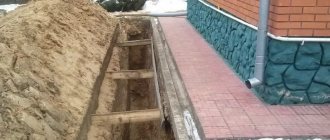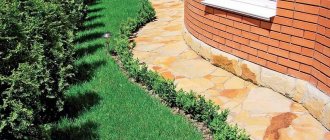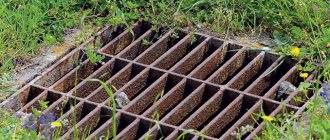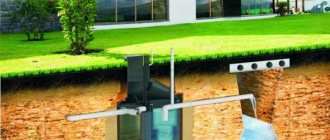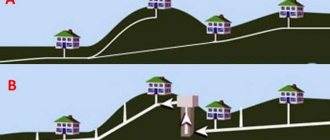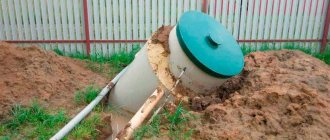Groundwater during sewerage installation
The laying of sewerage in groundwater must ensure absolute tightness; all connections are made with reliable protection against leakage using rubber or silicone seals. The pipes are welded into the storage tank with a special welding gun.
The wastewater pit is dug simultaneously with the pumping of incoming liquid from the ground. How to make a sewer system if groundwater is close is proposed in this article.
Risks of proximity to groundwater
Groundwater is an underground aquifer that is close to the surface of the earth. The groundwater level can rise if there has been heavy rain the day before or the snow is melting. In dry weather, the amount of subsoil moisture decreases. Increased soil water levels complicate the installation of treatment systems, wells and building foundations:
- the structure of the street toilet is destroyed.
- an unpleasant odor appears;
- the risks of intestinal infections increase;
- The service life of underground pipes is reduced - metal corrosion occurs.
- The walls of the cesspool are washed away by water, which prevents its cleansing.
There are several ways to understand how close groundwater is:
- Liquid level measurement. In the spring, you need to measure the water level in the well. A visual assessment is carried out by checking the filling of the tank after heavy rains or melting snow.
- If there is no well, you can drill several holes with a garden drill and see if they are filled with water.
If both technologies are not available to you, contact your neighbors who use on-site wastewater treatment plants.
Advice from experts - what to do even if groundwater is high:
- if groundwater gets into the cesspool, and you decide to dig it up and make drainage, do the work in the dry season;
- if you notice that water accumulates regularly, try this option: pump it out, leaving a little at the very bottom. Then, using pressure, beat the sediment for a long time and generously - all the sludge, even that which has already grown to the bottom and walls, will rise, and you can remove it;
- the bottom must be laid with coarse gravel, it will be able to hold back water and prevent siltation;
- adding bacteria capable of processing organic waste is another effective measure;
- think over the drainage system, perhaps the solution would be to install it additionally along the contour of the site; with their help, you can protect sewage from melt water.
Thus, it is quite possible to build a cesspool when groundwater is located high. It is necessary to take a responsible approach to the design, constantly monitor the filling level of the tank and clean the filler in a timely manner.
Construction of a cesspool
Construction of a sewer system in a private house with a high groundwater level in the form of a cesspool is undesirable. Possible flooding threatens difficulty in cleaning, rapid filling, erosion of the edges of the trench and destruction.
To avoid such problems, it is recommended to install a bioseptic tank. The tanks are absolutely safe for the environment. In country or country houses, other types of cesspools are also organized.
Storage capacity: installation features
The design is an ordinary pit, barrel or well made of concrete rings. The advantage of the structures is their low cost of construction. There are quite a lot of disadvantages:
- The container should never overfill, so choose products with a large capacity;
- at high groundwater levels, the tank must be regularly treated with sealants;
- place the structure in a place convenient for access by the sewage disposal service;
- Frequent calls for a sewer truck mean financial costs for the owners.
Storage tanks are inexpensive to build, but their operation can take a lot of time and money.
Installation of a mechanical septic tank
Country sewerage with a high groundwater level must be airtight. A mechanical septic tank is popular due to its price-quality ratio. Large costs at the initial stage are compensated by the simplicity and reliability of the system’s operation.
The degree of purification of waste liquids is adjusted by adding wells.
If the soil water level is low, 1 well will be sufficient; if the soil water level is high, 2 or 3 wells will be sufficient. The choice of materials for the construction of a septic tank must be approached responsibly, since with high groundwater it is necessary to prevent flooding of communications. Wells can be plastic or concrete, but the criteria for their organization are the same:
- When installing a septic tank from ready-made concrete rings, all joints must be carefully processed. This will prevent the structure from collapsing;
- The ideal option is to cast the well on site. To do this, you will need an iron form, which you can rent;
- When installed correctly, plastic septic tanks will be durable and effective.
The dimensions of an autonomous sewer system for a private house must be calculated correctly. Its capacity is equal to the amount of water consumed by a family of 4 people in 3 days.
How to arrange and protect a cesspool from melt water
As a general rule, the bottom of the pit should be located at least one meter from the groundwater mark. But if the standing level is very high, then you must adhere to the following:
- install special infiltration cassettes in the immediate vicinity of the structure. They are a kind of tunnels with different diameters. Their main task is to draw water into themselves and filter it. It is worth remembering that in winter they will freeze, so you need to take care of their insulation;
- As an option, experts advise installing storage wells next to the pit and digging a ditch. One tank will receive drainage from the pit, and the pump located in the second will help the purified liquid get into the ditch.
Advantages of a septic tank when groundwater is close to each other
Installing a sewer system in the form of a septic tank in a private house with a high groundwater level has many advantages:
- absence of unpleasant odor due to the tightness of the structure and ventilation.
- there is no need to call a sewer service. The waste decomposes and is discharged into the deep layers of the soil.
- there is no risk of soil contamination by waste. Waste liquids undergo thorough multi-level filtration. However, it is not recommended to install sewage drains near drinking wells.
With proper use, the structure will maintain durability and integrity.
TOP 10 factory cleaners
The rating of septic tanks for high groundwater levels is made up of products that have proven themselves on the Russian market, based on consumer reviews over the past year:
- Tank. Excellent price/quality ratio. Independent of energy consumption. Durable housing. A wide range of models with different volumes and devices.
- Triton. Excellent service life up to 50 years. Septic tanks of this brand require anchoring during installation. Large range of models of different volumes and shapes.
- Leopard. Three-chamber purifiers with 2-level biofiltration. Consumers note strength, reliability and durability.
- Tver. High capacity models. Requires a constant source of electricity and regular maintenance.
- Leader. 6-chamber septic tanks with airlift and aerators. They do not require biological additives for wastewater treatment.
- Ecopan. Withstand heavy loads. Recommended for installation in heaving soils.
- Unilos. A complex wastewater treatment process consisting of mechanical and biological stages. Reliable, easy to maintain models.
- Yubas. Durable septic tanks, suitable for effective operation with long breaks of up to 3 months.
- Poplar. Resistant to temperature changes and loads. Equipped with airlifts, compressors and aerators. Manual and mechanical sludge removal is provided.
- Topas. Reliable autonomous sewage system made of high quality materials. In demand among Russian consumers.
Operating principle of autonomous sewage system
Autonomous country sewerage, properly constructed when the groundwater level is high, can improve the quality of life of site owners. The multi-level system works according to the following principle:
- the used liquid flows into the septic tank, where insoluble inclusions are retained.
- solid particles settle at the bottom of the container, and fats and insoluble substances form a film on the surface.
- wastewater enters the septic tank compartments, where it is purified using anaerobic bacteria.
- the organic environment that comes with wastewater promotes the growth of bacteria, which reduces the concentration of harmful substances.
- ventilation removes the gases formed during the decomposition process.
The settled and clarified liquid enters infiltration tunnels, where it is purified and discharged into the ground.
Recommended types of septic tanks for high groundwater levels
When underground waters are close, in addition to the lateral pressure of the soil, the tank is affected by the backwater of water, and in winter also by the forces of frost heaving. Therefore, the walls of the structure must be strong and airtight. This can be provided by both factory models and construction-ready septic tanks.
Factory drive
The simplest and most cost-effective option for installing an autonomous sewer system in a country house or house for non-permanent residence is a storage septic tank. It is like a sealed cesspool or drainage pit. Wastewater flows through the supply pipe directly into the tank, from where, after filling, it is pumped out by a sewer truck.
Factory drives are made primarily of plastic. At high groundwater levels, polypropylene or fiberglass septic tanks are preferable, since products made of low-density polyethylene are not rigid enough and can fail due to frosty soil movements.
The containers are installed in the pit manually or using a lifting mechanism. The layout is preferable to a horizontal one, in which there is no need to dig a deep pit. This creates a lower groundwater pressure both during installation and operation.
In addition to ease of manufacture and installation, factory drives have the following advantages:
- complete tightness, no leaks;
- suitable for areas even with very high groundwater level;
- does not depend on power supply;
- meets the requirements of sanitary standards;
- affordable price.
Containers can be used not only temporarily, but also permanently. Free access for sewage disposal must be provided.
Made from reinforced concrete rings
Septic tanks made of reinforced concrete rings are very popular. To assemble the structure, products with a diameter of 1-2 meters and a height of 90 cm are used. Each element is installed on the previous one and secured with brackets. The seams are carefully sealed with waterproofing materials.
Concrete septic tanks can operate in 2 modes:
- gravity;
- with drain pump.
Since concrete is a permeable material, it is recommended to install a prefabricated septic tank when the groundwater level is no higher than 130 cm. In this case, it will operate normally.
The storage tanks are installed in series in the amount of 2-3 pieces and connected by overflow pipes. In the first chamber, sedimentation of solid particles occurs, in the second and third, biological breakdown by bacteria of various types.
Due to the insufficient degree of purification, clarified wastewater cannot be discharged onto the terrain. Further processing is carried out by filter fields, trenches, wells or infiltrators.
Advantages of septic tanks made of concrete rings:
- high strength, allowing to withstand lateral soil pressure and frost heaving without any deformation;
- no or very low power consumption;
- long service life.
Deep biological treatment station
A more technologically advanced method of wastewater clarification is SGBO, in which water is purified up to 98%. For areas with high groundwater level with permanent family residence, this is a convenient option that eliminates the labor-intensive installation of filtration fields.
The station is a multi-chamber (3 to 5) container with compartments designed for a specific type of cleaning:
- mechanical clarification zone, where solid particles precipitate, grease and films are retained;
- anaerobic fermentation chamber, in which biological processes take place without access to oxygen;
- zone of aerobic oxidation in the presence of oxygen and bioenzymes.
Biotreatment stations are equipped with drainage pumps, compressors, valves, airlifts and other devices that consume energy. The water obtained after purification can be used for technical purposes. The equipment is operated for a long time without pumping, maintenance is required once every 3 years.
Septic tank installation algorithm
Making a sewer system in a private household is not difficult if you follow the correct procedure.
Regulatory regulation of sewerage devices
A home cleaning system requires careful adherence to sanitary rules. The removal of sewage from the house, as specified in the requirements of SNiP 2.04.03-85, provides for:
- placement of treatment facilities 50 meters from drinking wells or wells.
- sewer lines are located 3 meters from the plantings.
- The septic system is installed at a distance of 5 meters from residential buildings.
- sewage disposal equipment must have unimpeded access to the treatment plant.
Planning of cleaning networks is carried out according to a strict order - 1 inspection well per 15 m of straight or rotary sections. Work must be carried out in strict order.
Digging a pit
Conducting home sewerage for a dacha, if groundwater is close to the ground, it begins with digging a hole:
- The pit completely includes the septic structure. In this case, the tank should not touch the walls at a distance of 25 cm;
- keep the bottom as even as possible, compacting it with wet river sand. Fine-grained material is laid in a layer of about 15 cm and thoroughly compacted. The sand should not contain foreign particles in the form of lumps of earth or gravel.
- To ensure the tightness of communications, sand is replaced with a concrete slab.
The walls of the pit must be reinforced with wood formwork or metal sheets.
Installing a septic tank in a pit
The finished septic tank is checked for cracks and damage before installation.
The container is lowered to the pit using cables. It must stand perfectly level in the pit, even the slightest tilt is unacceptable. In cold winter conditions, it is recommended to wrap the tank with a layer of heat-insulating material.
Backfilling the trench
After installation, the tank is filled with soil or a cement-sand mixture and thoroughly compacted. The ground level reaches the edge of the supply pipe.
It is not recommended to plant trees and shrubs above the septic tank structure - they can damage the treatment system.
Features of installation with close underground waters
To prevent the infiltration of contaminated wastewater both inside and outside, the storage tank must be absolutely sealed. The best choice for waterlogged soils is a septic tank made of polymers - polypropylene, polyethylene or fiberglass. The walls must be thick enough, and the structures must have stiffening ribs to withstand heavy loads.
Installation stages
Installing a septic tank under standard conditions includes the following steps:
- Digging a pit.
- Sand cushion installation.
- Immersion and leveling of the container.
- Laying sewer pipes.
- Filling the structure with water.
- Condition check, commissioning.
- Backfill with layer-by-layer compaction.
Features of installation in close water
At high groundwater levels, work differs from usual in a number of nuances:
- Groundwater can flow in large quantities. You need to stock up on a drainage pump for pumping.
- It is advisable to choose a horizontal layout of the septic tank in order to raise the bottom of the pit as high as possible.
- If the slopes crumble, install retaining walls made of boards or panels.
- To secure the container, a reinforced concrete slab with outlets is placed in the pit or a reinforced concrete cushion is installed with anchors made of reinforcement. After immersing the septic tank, it must be secured with steel slings so that the installation does not float when lifting the water supply system. This is especially true for lightweight plastic structures and metal caissons.
- Sewer and overflow pipes, connecting elements, and drainage field must be raised as high as possible. If they are even periodically under water, the system will overflow and will not work.
- The neck of the structure is raised to a height of up to 30 cm above ground level, and an insulated blind area is installed around it.
- The joints in a prefabricated septic tank made of reinforced concrete rings are carefully sealed with waterproofing mixtures.
Arrangement of the infiltrator
Filtration structures must be connected to the container to purify the water before it enters the ground from the container. There are several options:
- Filtration fields with a bed of gravel and sand, on which drainage pipes with perforation are located along an inclined line. The length of the pipes reaches 20 meters, and the distance of the extreme points is 2 meters. The seepage is located 1 meter higher than the expected elevated aquifer.
- Water supply to a ditch is suitable for clay soils. Filtered water is removed using pumps.
- A water intake for a home, like a filter, is built when the water is planned to be used for agricultural needs, or it is not possible to build another structure. Pipes are connected to the tank from the septic tank. A sand cushion must be built around it. To protect against overflow, an outlet pipe is constructed, which, if there is a large amount of water, discharges it into an underground filtration field, a ditch, or back into the septic tank.
- A good solution for a private house with a high groundwater level is a ground filter cassette. It is constructed as follows: they dig a hole 50 cm deep, which is filled to the top with sand.
- foam blocks about 30 cm high are laid around the perimeter.
- crushed stone is poured inside.
- A filter cassette made of plastic and insulation is placed on top.
Your sewer septic tank will begin to function normally only after 2-3 weeks. During this period, a sludge sediment forms at the bottom of the tank, which actively participates in the waste processing process. The quality of a sewer system made by yourself at the dacha directly depends on the quality of the containers and pipes used, as well as the correct installation.
Proper construction of a dacha sewer system at a high groundwater level will ensure filtration of waste liquids by 99%.
However, the resulting water is not suitable for food and is exclusively technical.
Article Rating
How to determine groundwater level?
A geological study based on several test drillings provides an accurate picture. It is ordered from a licensed company. This solution costs money, but you will have documents that are important for control authorities.
An alternative is to conduct the research yourself:
- Using a garden drill, boreholes up to 2 m deep are made in several places (at least one of them is in the area where the future septic tank will be located);
- Having covered the pits from the rain, they are left for a day;
- on a wooden slatted or metal rod 2.5 m long, marks are applied every 5-10 cm;
- lower the meter into the well, immediately pull it out and mark the boundary of the wet area;
- Having wiped and dried the strip, it is lowered into the next hole, etc.;
- within 3 days, measurements are repeated several times (at the same wells).
The calculation is simple: if a rod installed at the bottom of a 2-meter well is 30 cm deep in water, the groundwater level is 2 - 0.3 = 1.7 m from the earthen surface. The groundwater level changes significantly throughout the year: it increases during the wet period and decreases during the dry period. The maximum level is of interest, so surveys are carried out in early spring (as soon as the snow cover melts) or in summer and autumn after prolonged rains.
The following methods help make a preliminary assessment of groundwater level:
- survey of neighbors who have lived in the area for a long time.
- folk method: having removed the turf in several places, place glass jars or clay pots upside down and in the morning check whether there is condensation on them inside. If there is water, the water is close. Another option: on the soil freed from turf under the pot, place a small amount of fat-free wool and a fresh chicken egg on it. In the morning, check for condensation on the egg; if there is any, the GWL is high, if not (even if the wool is moistened), it is low.
A good result is obtained by analyzing the plants covering the area if the following are present:
- downy birch, reed and cattail, marsh wild rosemary and Langsdorff's reed grass, sedge - the GWL is most likely 0.5 m or even higher;
- canary grass or meadowsweet - from 0.5 to 1 m;
- fescue, mouse pea, white bentgrass, heather, sandy reed, blackberry - from 1 to 1.5 m;
- Lingonberry, juniper, creeping wheatgrass, meadow clover, plantain, licorice, yellow alfalfa - GWL below 1.5 m.
A high groundwater level is indicated by heavy morning dew and evening fog, a swarm of midges, and the absence of ants.
